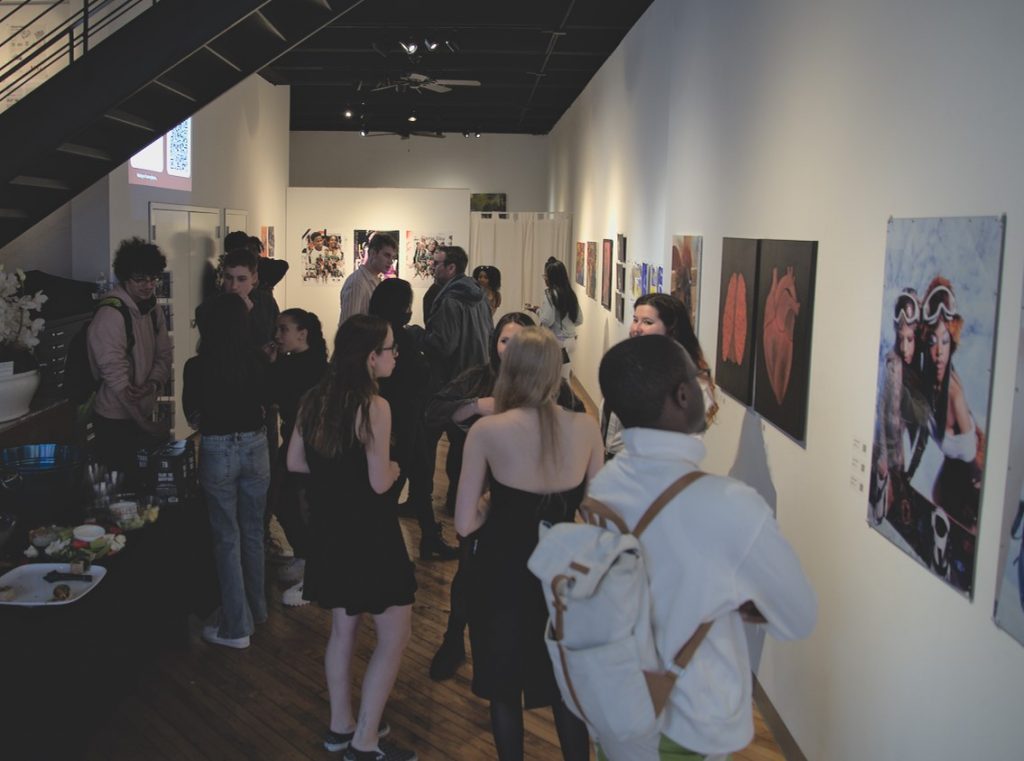After four years of hard work, Binghamton University students in Fine Arts came together to share their unique artwork at the AFTERSHOCK exhibition. From April 28 to May 2, the installation at the Anthony Brunelli Fine Arts Gallery featured 11 seniors who are receiving a bachelor of fine arts degree, with concentrations including painting, photography, graphic design, drawing and future media. The extensive range in concentrations and experimentations seen by each artist allowed for a diverse set of mediums and subject matter, showcasing the artistic variability of each artist. On the last day of the exhibition, each student spoke about their work on display, as well as their individual process as an artist.
The talent behind each artist was evident through viewing their physical work, with Alisha Brunelli, Binghamton University lecturer of art and design, providing a more thorough insight as to what mechanisms go into preparing for an exhibition. Brunelli described the steps taken to familiarize students with exhibition spaces in her senior exhibition course. The class attended museums, galleries, local web and branding agencies and acquired knowledge about the presentation and experience of one’s work. While the majority of the group did not have prior exhibition experience, the goal of familiarizing with the space allowed their individual talents to shine through. Brunelli was especially proud of the diversity that each student brought through their range in medium and expertise.
“I think it’s great to see the diversity that all of the students bring in our department,” Brunelli said. “It’s so cool to see anything from [user interface and user experience] design to more traditional painting to anything in between. It’s just exciting to see all of the levels of creativity and all of the different kinds of materials and output, and also in a course like this seeing everyone work together for a common goal, through the exhibition.”
While the physical and visual format of each work varied, themes of social issues were prevalent throughout much of the installation. From issues such as body dysmorphia to the underrepresentation of Black people in the media, the vulnerability and passion behind each artist were apparent.
Jabari Browne, a senior majoring in an individualized major in future media, brought to light the limited representation of blackness that has thus far been portrayed to the public. Browne broke down his work and what he hopes to depict in his photography.
“My work would be described as just capturing Blackness and the multidimensionality of Blackness, trying to put people who have been underrepresented in different spaces and environments that I would like to see them in,” Browne said.
Browne attributed the evolution and truthfulness of his work to his accumulation of confidence throughout the artistic process.
“When I first started I didn’t have the confidence to produce the images that I was seeing, so just going through the process of creating and failing and creating I was able to hone my skills in order to really execute the ideas I was seeing in my head,” Browne said.
In addition to Browne’s individual growth as an artist, he referenced the importance of collaboration as a significant element in his ability to realize his vision and reinforce important social concerns, such as the multidimensionality of blackness.
“The vibe of intimacy is really portrayed through the artwork and then I work with my best friend who is a photographer, and so our vision together is really what’s displayed within the artwork today,” Browne said. “Find people who have a similar mindset to you and try to see how all of your different artistic abilities can mold together to create a vision, a collective vision.”
Esther Brodsky, a senior majoring in art and design, explained how their work demonstrated a reflection of their personal struggles, but also that in her individualized journey she hoped to positively impact those who can form connections. Brodsky’s combination of sketch-like drawing with graphic novel storytelling highlighted how autobiographical accounts can formulate strong messages to viewers.
“I like to sort of write more about thoughts that when I say them in my head I don’t feel like I’ve heard people talk about them as much,” Brodsky said. “And to be able to put that out so that if people are thinking of that and they are too afraid to say it, that they can find themselves in it or that they can just understand me better.”
Brunelli commented on such honest depictions of social issues, and commended the artists for their bravery.
“I think it’s very brave first of all to bring those very personal issues out into a place that can be seen by many people, and so the bravery alone I think is inspiring,” Brunelli said. “And I think other people seeing that it’s okay to talk about certain topics and that it’s okay to feel like you’re maybe not alone in a particular way, it’s huge. It’s a big deal.”
Each of the artists has their own reason to feel accomplished, achieved through the exhibition format and celebration of their work. There was an exquisite skill seen in both realistic and mixed media portraiture, ranging from oil paintings to large-scale collages. Sculptures pushed graphic design majors outside of their comfort zone in order to evoke discussion about mental health and societal norms. The boundaries and implications of graphic design were revealed through formats such as web and app design and sports advertisements. Through and through, artists found specific ways to represent what art looked like to them and shared their refined knowledge with viewers of the exhibition.



